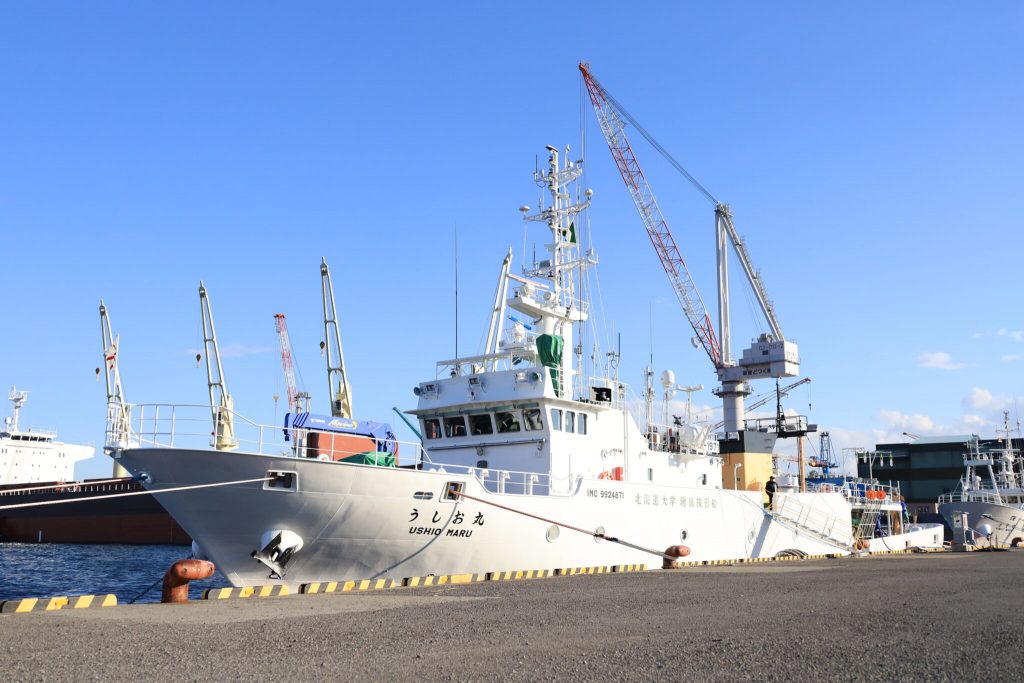Japan (Hokkaido University) Ushio-maru III Completion Ceremony held

On November 4, 2022, a ceremony was held at the Hakodate Research Center for Fisheries and Oceans in Hakodate City, Hokkaido, to celebrate the completion of the training vessel Ushio-maru, owned by the School of Fisheries Sciences, Hokkaido University. The first generation Ushio-maru was built in 1971, followed by Ushio-maru II, which was built in 1992.
The newly completed Ushio-maru III is slightly larger than its predecessor, with an overall length of 45 meters, a gross tonnage of 262 tons, and a capacity of 33 passengers. In addition to increased speed and stability, the Ushio-maru III carries a large number of state-of-the-art research equipment. To accommodate the increasing number of female students and researchers, many improvements have been made to the accommodation space.
At the ceremony, Hokkaido University President Kiyohiro Houkin expressed his gratitude to all those involved and said, “We would like to utilize the Ushio-maru to contribute to the sustainable use of the ocean, a common asset for all humankind, and to develop human resources for this purpose.” Mr. Takakuni Ikeda, Director General of the Higher Education Bureau of the Ministry of Education, Culture, Sports, Science and Technology, delivered a congratulatory address (read on his behalf), followed by a progress report on the shipbuilding by Professor Toru Mukai, Chair of the subcommittee on substitute ship construction, School of Fisheries Sciences, Hokkaido University.
The School of Fisheries Sciences of Hokkaido University owns two training vessels, Oshoro-maru and Ushio-maru, which are used for practical training, surveys, and research. The larger Oshoro-maru is an “offshore campus” that carries a large number of students for basic training, while Ushio-maru is a “mobile laboratory at sea” for advanced and highly specialized education and research. In addition, while Oshoro-maru makes oceanic, long-distance voyages to the Arctic and other regions, Ushio-maru specializes in subarctic coastal areas north of the Tohoku region.
Aboard the Ushio-maru III, Mukai commented, “I am overwhelmed. I feel that we must nurture good human resources (by utilizing the Ushio-maru). Students might experience the harshness of the sea, but I hope that they will develop into experts who protect the richness of the sea.” State-of-the-art equipment, including fishfinders and scanning sonar, has been introduced to the ship, with which he says they are now able to perform more detailed analysis, including the detection of fish in the surface layer. Professor Mukai concluded, “My ultimate dream is to develop a fish finder that can identify fish species, which is difficult with current technology.”
Tetsuya Takatsu (Professor, Faculty of Fisheries Science), a member of the subcommittee, said, “It took longer than planned because of the new coronavirus pandemic, but I finally feel relieved looking at the completed vessel.” Given the fact that the world’s population continues to increase, making it necessary to utilize fishery resources in a sustainable manner, he hopes to clarify the mechanism by which fish populations increase or decrease in the natural environment. “The mechanism of the fluctuation is still largely unknown,” he said. “We need to study each fish species one by one in order to make good use of nature’s surplus production and to prevent the overuse of resources. There is no end to fisheries science.”
Captain Keiichiro Sakaoka of the Ushio-maru said, “The new Ushio-maru is fuel-efficient and fast. The ability to return to port at full speed in an emergency is important for the safety of the passengers. Also, since the ship is now more stable, it is less affected by the weather and can sail under a wider range of conditions, which I think will contribute to advancing practical training and research.” Sakaoka, who has seen many students on the ship, mused, “After a long voyage, their faces are different when they get off the ship compared to when they get on, probably because they become more confident.” He added, “Hokkaido University, which is strong in field research, provides students with such experiences, and I hope they will take advantage of them.”
Yasuaki Takagi, Dean of the School of Fisheries Sciences, said, “When you are on a ship, being isolated away from land, you cannot live or do research without cooperating with each other. I hope students will learn not only specialized techniques but also how to work as a team.” He also mentioned the international environment of Hokkaido University and that students may gain international experience on board. He added, “I would like to make the ship a place where we can realize the ‘lofty ambition’ preached by the first vice principal of the Sapporo Agricultural College, the predecessor of Hokkaido University. If you like the sea, I would like you to join the School of Fisheries Sciences.”
Just a couple of days after the ceremony, Ushio-maru III set sail on a voyage with 8 students and instructors on board. Bon voyage!
